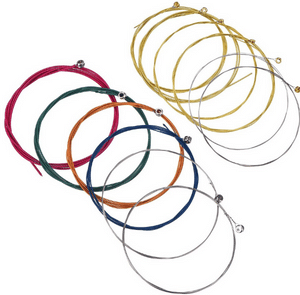
Are you trying to find the right strings to make your guitar sound and play great? Your string gauge can make all the difference! In this guitar string gauge guide, I’ll show you exactly how to figure it all out!
Changing your string gauge usually means that you need to adjust your guitar to prevent it from being damaged by the difference in string tension.
Keep on reading to learn more.
What Is A String Gauge?
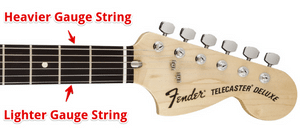
A guitar string’s “gauge” refers to the string’s diameter or how thick the string actually is.
Each string has a specific gauge, with the lowest pitch string on the guitar being the thickest and the highest pitch string being the thinnest (smallest in diameter).
Guitar strings have their gauge size written on the box and/or envelope they come packed in. It’s important to understand that the gauge can vary on the same name string. So, the D string on one guitar can be thicker or thinner than the D string on another guitar.
Thicker strings are usually called “heavier” gauge, while thinner ones are “lighter” gauge.
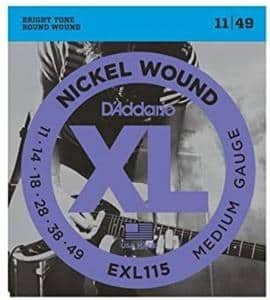
Why String Gauge Matters
String gauge affects the sound of your guitar and changes the way the strings feel and perform under your fingers. This can ultimately affect the way you play in a significant way.
It’s not just your fretboard playing dynamics that can change. Different string gauges can also affect how you strum the strings and the pick thickness you need to make them sound good.
Play a variety of guitars, and you will notice the effect of different string gauges.
String gauge is one of many reasons professional players will use a particular guitar for a specific song or style of music.
After you have been playing for a while, the best string gauge to use on each guitar you own will become “second nature.”
The Pros And Cons Of String Gauges
Here are some of the things to consider when choosing the gauge of a string set.
| Consideration | Thinner Gauge | Thicker Gauge |
|---|---|---|
| Playability | Easier on the fingers | Requires more finger callus formation |
| Sustain | Notes sustain less | Notes sustain longer |
| Chord Definition | Chords sound less full | Chords are richer sounding |
| Durability | Strings break easier | Strings last longer |
| String Bending | Easier to bend (and break) | Harder to bend (and break) |
| Suitability | Rock, Blues, Metal, Country | Country, Jazz, Folk, Classical, Flamenco, Drop-Tuned Metal |

Which String Gauge Is Right For You?
Finding the correct gauge strings for your guitar is always a matter of experimentation.
If you play electric guitar and you like soloing, chances are you will want to use lighter gauge strings. They are easier to press down onto the frets and bend to pitch. Lighter gauge strings allow you to play faster and bend your strings more aggressively.
Rhythm guitar players usually prefer heavier gauge strings, which make chords sound fuller and ring out longer. If you play rhythm guitar in a rock band, heavier gauge strings can make your power chords sound massive.
It’s common to see rock and blues players use lighter gauge strings, while jazz and classical players use regular or heavy gauge strings. Country players will use a lighter or heavier gauge, depending on how much string bending they typically do.
If you alternate between playing rhythm and melodic passages or guitar solos, you will probably use a string gauge set that is somewhere between light and heavy (i.e., medium gauge).
For players with arthritis of the hands, guitar type and string gauge is important. For more info, see Playing Guitar With Arthritis: Overcoming Your Hand Problems.

My Personal Journey With String Gauge
When I first started playing electric guitar many years ago, I quickly became obsessed with the best brand and string gauge to use on my Fender Stratocaster.
There weren’t anywhere near the number of string choices back then compared with today (thank God for that), but I tried almost everything available over 3 to 4 years.
I finally found a set of Dan Armstrong Ultra-Light (7-38) strings that seemed perfect for playing solos over a simple power-chord background. I still have an original .007 E-String in my toolbox that I’m thinking of donating to the Smithsonian.
I would never use this gauge string today, even though Dunlop is making a 7-38 set. The point is that your string set gauge can change as your playing style & ability and guitar choice evolves.
So, don’t concern yourself too much with string gauge changes if you would like to experiment a little. It’s all part of the fun of playing the guitar!

The Downside Of Light Gauge Strings (Are They Legit?)
My story isn’t unique. Beginning electric guitar players are almost always looking for a way to make it easier to play faster.
If you’re exploring the possibility of changing to lighter gauge strings, you should consider a few things.
Lighter string gauges are more likely to break with bending, go out of tune, and wear out quicker than heavier sets.
Although lighter gauge strings are indeed easier on uncalloused tender fingers and can let you play faster, they won’t necessarily:
- Improve your timing, precision, and accuracy
- Let you play more expressively, which is not the same as being able to bend the stings farther or vibrato quicker
- Get the best sound from your pickups, no matter how close you set them to the strings
So, although light gauge strings are legit, you shouldn’t necessarily begin with the lightest gauge available.
Most electric guitars come set up and factory-strung with a 9-42 gauge string set. This is a great place to begin since they are not too thick or thin.
A good rule-of-thumb is to learn how to play well on a 9 gauge set and only move down in gauge if it allows you to perfect a playing technique that you can’t master with additional practice.
If you find it challenging to play on a 9 gauge string set or want to move up a string gauge for better sound, one excellent approach is to get an acoustic guitar and play it every day. This not only strengthens your fingers but also trains them to function appropriately on higher tension strings.
Playing 9-gauge strings will seem easy in comparison when you pick up the electric and, you might even be tempted to move up to a 10-gauge set.

A “Tale Of Two String Gauges”
There are pros and cons to light and heavy gauge string sets but there are always guitar slingers that set the standard in one direction or the other.
For example, here are two totally awesome players on opposite ends of the string gauge spectrum.
Stevie Ray Vaughan
Stevie had an incredible sound that he got from his finger mechanics and fairly thick gauge strings. He used a .013 – .017 – .026 – .036 – .046 – .056 string set on all his Strats.
To approach Stevie’s speed, string bends, and finger vibrato on this string set, you really have to work up to it slowly and develop fingers of steel.
Stevie mentioned in interviews that there were times during a long set when he would have to superglue his callouses back onto his fingertips. Ouch, that hurts just thinking about it!
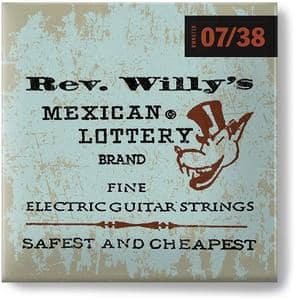
7-38 Gauge
Billy Gibbons
Billy is an absolute master of guitar tone and a true “sphinx” when it comes to string gauge! Unlike Stevie Ray Vaughan, he prefers the thinnest strings available.
Dunlop worked with Billy to develop a custom set of .007 – .009 – .011 – .020 – .030 – .038 strings and marketed them as “Rev. Willy’s Mexican Lottery Brand.”
It’s amazing how he gets such a huge and toneful sound out of these skinny strings, but that’s Billy for you, one fabulous player, to say the least!
Moral Of The Story
So, the moral of the story is that each player is unique and needs to find the string set gauge that works best. Follow your vision of what you are trying to accomplish with your music and strive to create the sound in your head and heart.
Technical considerations, such as string gauge, guitar type, amps, and effects, are simply tools to help you develop your talent, which is ultimately expressed through your hands.
String Gauge Classification
Guitar strings are sold in sets, and each set has a gauge classification. Always change all the strings on your guitar at once when they begin to wear out.
Strings that are sold separately are good to have if you break a string while playing. Keep a set of fresh strings and some singles in your guitar case. You never know what will happen, and “the show must go on!”
Electric Guitar String Gauges
There are many ways to classify electric guitar string gauges. Each string maker has its own set of specifications and names for them. Here’s the way I think of the various string set gauges.
The string gauges are in inches. The top three strings (E, B, and G) are plain, and the bottom three (D, A, and E) are wound.
| Gauge Designation | E | B | G | D | A | E |
|---|---|---|---|---|---|---|
| Ultra-Light (7-38) | .007 | .009 | .011 | .020 | .030 | .038 |
| Super-Light (8-38) | .008 | .010 | .015 | .021 | .030 | .038 |
| Extra-Light (9-42) | .009 | .011 | .016 | .024 | .032 | .042 |
| Light(10-46) | .010 | .013 | .017 | .026 | .036 | .046 |
| Light with Heavy Bottom (10-52) | .010 | .013 | .017 | .030 | .042 | .052 |
| Medium (11-49) | .011 | .014 | .018 | .028 | .038 | .049 |
| Regular (12-54) | .012 | .016 | .020 | .032 | .042 | .054 |
Acoustic Guitar String Gauges
Acoustic guitar string gauges are more straightforward than electric strings. Here’s how I think of the various string set gauges.
The string gauges are in inches. The top two strings (E and B) are plain, and the bottom four (G, D, A, and E) are wound.
| Gauge Designation | E | B | G | D | A | E |
|---|---|---|---|---|---|---|
| Extra-Light (10-47) | .010 | .014 | .023 | .030 | .039 | .047 |
| Light (11-52) | .011 | .015 | .023 | .032 | .042 | .052 |
| Medium (12-54) | .012 | .016 | .025 | .032 | .042 | .054 |
| Regular (13-56) | .013 | .017 | .026 | .035 | .045 | .056 |
| Heavy (14-59) | .014 | .018 | .027 | .039 | .049 | .059 |

String Gauge Checklist
Here is a checklist of some things you should do before changing your guitar string gauge. I’m speaking from experience here!
Be Patient
Have you tried playing with the string gauge that came preinstalled on the guitar you just bought? It takes your hands a while to get used to any new instrument, so don’t be hasty. The guitar is already properly adjusted to play and sound best with this gauge.
Clean Or Replace What You Already Use
If your strings get dirty or wear out, then your guitar may not sound or play correctly. The first step should always be to clean or replace the entire string set, especially if your hands sweat a lot. If you were initially happy with the strings, then stick with the same brand and specs.
For more info, see Why Change Guitar Strings? – Tips To Play And Sound Awesome!
Change Brands Before Gauge
If a fresh set of strings doesn’t do the trick, it might be time to take the next step. Consider changing to a different string brand before changing the string gauge.
Get A Guitar Setup
The answer to your playing problem may be as simple as adjusting the action (string height) or intonation on your guitar. Sometimes more sophisticated adjustments are required, especially if you have an acoustic instrument.
If you are not experienced in the proper way to perform a setup, then you could cause permanent damage to your guitar, so take it to a tech or luthier and get it done right!
See How To Set Up An Electric Guitar – Be Dangerous On 6 Strings for more info.
Choose Your String Gauge Wisely
Once you’ve tried all the steps above, then make a conservative change in the string gauge. Don’t skip gauge sizes.
Going from a .010 to a .008 string set may be more than you need, and your guitar will definitely require a truss rod adjustment. The in-between gauge (.009 in this case) is the next logical choice for light strings.

String Gauge Changes For Intermittent Players
What about if you stop playing for a while? Should you drop down a string set gauge to make it easier to recondition your fingers?
I recommend you begin playing again with the same string gauge you were comfortable using before you stopped.
Inspect your strings and clean or replace them with an identical set if they are dirty, rusted, or sound dead.
Organize your practice schedule to play daily for short periods and gradually increase as tolerated. Stop immediately if your hands or fingers become sore. This approach will allow you to rebuild your finger callouses as you get back into the swing of things.
It also lets you avoid changing back to your original gauge string set and two guitar setups.
For more info, see Fingertips Hurt Playing Guitar? – How To Stop The Pain!

Best String Gauge For Drop Tunings
Drop tuning involves lowering the pitch of one or more strings. Some drop tunings require thicker gauge strings, especially for the three “bass” (E, A, and D) strings, to keep adequate tension on them when tuned down.
If your bass strings are detuned too much, they can become “flabby” and hit against the frets when they vibrate. This can cause “fret buzz” and intonation problems. The solution is to use heavier gauge strings and make adjustments (a setup) to your guitar as required.
The advantage of drop tunings in Rock or Metal is that the guitar can play in a lower register to give you “heavier” sounds.
Tony Iommi, the guitar player for Black Sabbath, popularized drop tuning. He tuned down to help accommodate his finger injury and, in the process, became the “godfather of heavy metal.”
Here are four examples of drop tuning for 6-string guitars and the string gauges I recommend using. Each drop tuning allows you to play a power chord (1, 5, octave) on the bottom three strings using a one-finger bar.
The same principles apply for 7 and 8 string guitars.
Drop D Tuning
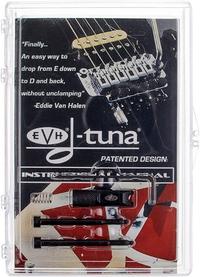
Drop D tuning is probably the most popular drop tuning for rock music. It gives you a heavier sound than regular tuning, especially when playing power chords on the bottom three strings.
It’s an easy tuning modification to make (on a guitar without a whammy bar) while you’re playing without changing guitars because you only have to drop the low E string one step. The other five strings remain the same.
For guitars with a Floyd Rose bridge (whammy bar double-locking system), you can install an EVH D-Tuna to instantly change from regular to drop D tuning without re-tuning all six strings.
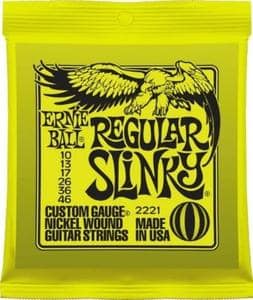
Some guitars come with a D-Tuna pre-installed on a Floyd Rose bridge.
The other advantage to using Drop D tuning is that your guitar will probably not require a setup since you are only dropping the pitch of a single string.
I recommend using at least 10-46 gauge strings (see the table above) or heavier. I find that the dropped D string can sound a little “wimpy” in a Rock context with lighter gauge strings, but 9-42 will usually be ok.
A Light with Heavy Bottom (10-52) string set is ideal.
Drop C Tuning
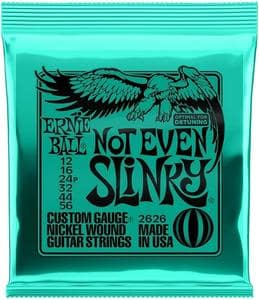
Drop C tuning gives you a heavier sound than Drop D tuning. Metal bands frequently use it. With this tuning, the low E string is dropped down two steps to C, and the other strings are all dropped 1 step in pitch.
The problem with Drop C is that the guitar will need to be kept in this tuning and be set up to accommodate the lower string tension.
This means that if you are playing a set with songs in regular pitch and Drop C tuning, you will need to change guitars between songs.
If the guitar is not adjusted correctly for this string gauge, it won’t play in tune and can be permanently damaged!
For Drop C tuning, I recommend using a 12-56 gauge string set. The Ernie Ball “Not Even Slinky” string set is an excellent choice.
Drop B Tuning
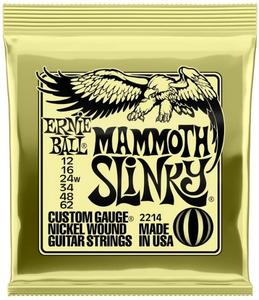
Drop B tuning will give you a significantly “heavier” sound on all six strings than Drop C tuning.
This tuning is favored by some of the more “hardcore” metal bands, and it can give you some very “dark” sounds!
Drop B tuning requires the low E string to be lowered 2 and 1/2 steps, and the other five strings each lowered 1 and 1/2 steps.
Like the Drop C tuning, the Drop B tuning requires a dedicated guitar with a particular setup to compensate for the low string tension.
If the guitar is not adjusted correctly for this string gauge, it won’t play in tune and can be permanently damaged!
For Drop B tuning, I recommend using a 12-62 gauge string set. The Ernie Ball “Mammoth Slinky” string set is an excellent choice.

Drop A Tuning
Drop A tuning gives you even “heavier” sounds on all six strings than Drop B tuning, low enough to make your teeth rattle in your head!
The most devout heavy metal monsters use it.
Drop A tuning requires all six strings to be lowered 3 and 1/2 steps! So, the guitar plays exactly the way it did in standard tuning, except that the tonal range is drastically shifted to the low end. After you learn where all the notes are on the neck, the chords, scales, and arpeggio shapes are the same.
Like the Drop C and Drop B tuning, Drop A tuning requires a dedicated guitar with a particular setup to compensate for the low string tension.
If the guitar is not adjusted correctly for this string gauge, it won’t play in tune and can be permanently damaged!
For Drop A tuning, I recommend using a 12-62 gauge string set. The Ernie Ball “Mammoth Slinky” string set is an excellent choice.
Drop Tuning Comparison Chart
Here is a summary chart that compares regular tuning to Drop D, C, B, and A tuning, along with the string gauges I recommend.
| Tuning | String Gauge | 6th String | 5th String | 4th String | 3rd String | 2nd String | 1st String |
|---|---|---|---|---|---|---|---|
| Regular | Any Gauge | E | A | D | G | B | E |
| Drop D | 10-46 | D (1) | A | D | G | B | E |
| Drop C | 12-56 | C (2) | G (1) | C (1) | F (1) | A (1) | D (1) |
| Drop B | 12-62 | B (2 ½) | Gb (1 ½) | B (1 ½) | E (1 ½) | Ab (1 ½) | Db (1 ½) |
| Drop A | 12-62 | A (3 ½) | E (3 ½) | A (3 ½) | D (3 ½) | F# (3 ½) | B (3 ½) |
For more info on drop tunings in heavy metal, see Where Did Heavy Metal Originate? – Fascinating Facts!

Beware Of Your Guitar’s String Gauge Requirements!
Generally speaking, you can usually move up or down a gauge without absolutely needing a setup on your guitar. This assumes that you can live with the minor tuning and intonation discrepancies that come with the gauge change.
However, if your guitar has a “floating” bridge with a whammy bar, it will require adjustment, which is typically pretty easy to do.
So, if you move more than one string gauge in either direction, be prepared to get a guitar setup.
Drop Tuning Requirements
Drop D tuning can use regular gauge strings and does not usually require a special setup for your guitar.
Drop C, B, and A tunings use substantially thicker gauge strings and will require a setup to address some or all of the following adjustments.
- The nut slot(s) may need to be widened
- The nut may need to shimmed or a new nut may need to be installed
- The truss rod will need to be loosened to accommodate the decreased string tension
- The bridge saddles may need to be replaced or have their slots widened
- The bridge saddle height will need to be raised to increase the string action
- The bridge saddle positions will need to be changed to adjust the string intonation
Setup Disclaimer
Please do not attempt to do a setup on your guitar if you are inexperienced, especially truss rod adjustments. You could permanently damage your guitar. Take it to a professional guitar tech or luthier to get it done right.
For more info, see How To Fix Guitar String Problems – Easy Things You Can Do!

Frequently Asked Questions
Here are some of the most frequently asked questions about guitar string gauges.
Do Heavier Gauge Strings Sound Better?
Not necessarily, but heavier gauge strings usually do sound fuller and louder. A cheaper or improperly matched string set can make your guitar sound worse, even with a higher gauge.
Many other factors need to be considered that relate to the design, function, and setup of the guitar.
Do Heavier Gauge Strings Buzz Less?
Yes, if the guitar is set up correctly, then a heavier gauge string will tend to buzz less since it vibrates less in all directions when it is struck than a lighter one.
Why Are Higher Pitch Strings Thinner Than Lower Pitch Strings?
Higher pitch strings, like the high E, B, and G strings, need to vibrate faster when struck. Their smaller diameter gives them less mass, which is inversely proportional to their frequency of vibration. So, thinner and lighter strings vibrate quicker to create higher pitch tones.
Do Lighter Guitar Strings Have Less Tension?
Yes, the lighter the gauge, the lower the string tension, which means the string will be easier to press down onto the fret and bend or do finger vibrato.
Do Light Gauge Strings Break Easier?
Yes, generally speaking, lighter gauge strings will break easier, especially if you use a whammy bar aggressively or do wide finger bends. The high E and B strings are usually the ones that break.
If you are breaking stings frequently, your guitar may need a setup or a change to a higher string gauge.
What Difference Does Guitar String Gauge Make?
Thicker gauge strings have more sustain and a fuller tone. The thicker the gauge, the greater the electromagnetic force they will induce in a guitar pickup, sending a more robust audio signal to the amplifier. The opposite is true for thinner gauge strings.
For more info, see Humbucker Pickups VS Single Coil – Improve Your Guitar Tone!
Do You Need A Setup After Changing String Gauge?
Any change in string gauge can affect the way your guitar plays and sounds. Even a small change, such as going from a 9-42 gauge set to an 8-38 set, can require a setup to get everything properly adjusted, especially if you have a floating bridge with a whammy bar.
A guitar setup may not be necessary if you move up or down a single string gauge.
Does String Gauge Affect Tuning?
String gauge can affect tuning, especially if your guitar is not correctly set up. Several other factors can affect tuning, such as the tuning machines, nut, neck, pickup height, and bridge.
Does Changing String Gauge Affect Intonation?
Yes, using a different gauge string set can affect your intonation, especially if the change is significant. Using a thinner gauge string can flatten intonation and vice-versa.
Can Higher Gauge Strings Damage A Guitar?
If a set of guitar strings are correctly installed, which means setting up the guitar to match the overall string tension, then using a higher gauge will not damage your guitar. Be sure to use the correct type of strings for your guitar.
Never put steel strings on a classical guitar, which can only be strung with nylon or gut. The higher tension of steel strings will damage the guitar and may loosen the bridge.

Final Thoughts On The Guitar String Gauge Guide
Guitar string gauge can definitely affect the way your guitar plays and sounds. Using the proper type and gauge string takes experience and some degree of trial and error.
Every guitar and player is different, so there is no “one size fits all” solution. If you own several guitars, then chances are you use more than one brand and gauge of guitar strings.
If you are a beginning player, don’t automatically change your strings to the lightest gauge you can find. A lighter string gauge is not a substitute for practicing to develop the skills you need to play well and sound good.
Begin using the string gauge that your guitar came with when you purchased it. This is most likely the most common gauge for that guitar, and the instrument will have been appropriately set up to accommodate it.
Go through the checklist in this article before targeting a string gauge change as the solution to your problem.
If you want to experiment with drop tunings, your guitar may need to remain in that tuning and be set up to sound and play appropriately with a particular gauge string set.
Do not attempt to do a setup on your guitar without the proper tools and experience. You could permanently damage your instrument. Take it to a qualified guitar tech at your local music store or a luthier (someone who builds and adjusts guitars).

Tell Me What You Think
Please leave a comment below if you enjoyed this article, have any questions about guitar string gauges, or want to give your point of view. I will be happy to help you.
- What string set gauge are you using on your electric or acoustic guitar? Why?
- What’s the lightest string gauge you’ve ever used? The heaviest?
- Do you use drop tunings? Which one(s)? Are you using a special string set?
- Any pros and cons of string set gauges that I neglected to mention?
- Has this article made you consider changing your string set gauge? Why?




Hi. Ever since I took delivery of my newest LP style no-name clone I have been wondering what gauge strings to put on it. I know we watch all those Youtube videos of people testing out cheap guitars and the very first thing they do is chop off whatever stings came with it and put a new set on. I just can’t bring myself to cut through a perfectly good set of strings even if they are the cheapest out there. I just think it makes more sense to play them and change them out when they are worn or when they break. It never occurred to me though that as you say, the guitar was likely set up for exactly the gauge of strings that it came with.
Years ago, when I was playing much more I would always look for the slinkiest strings available just so I could play fast and bend the notes more easily. Now it is much more about re-educating my fingers and building back dexterity, control, and calluses so best to stick with the medium-light gauge the guitar came with. Practicing on a 12-string helps too. Best regards, Andy
Hi, Andy
I appreciate your comments!
I would play through the strings that came on the guitar if they sound ok—no sense in wasting money. If you like the feel of that gauge, then measure them before putting on the new set. I use a micrometer but, you can also use a digital caliper. Using the same gauge will save you a guitar setup.
Playing acoustic is the quickest way to condition your fingers for the electric. 12-strings guitars are even better and a lot of fun to mess with!
Keep on playing, and you’ll get back all your chops and even surpass that!
Frank
Excellent article regarding guitar string gauges! It is never easy to select or buy the correct strings and also apply them to one´s guitar! The chart you created with the pros and cons is something really cool! I believe every guitar player should have it handy as it would saves us a lot of time and headaches!
Thanks again!
Hi, Johnny
Thank You for your comments!
Selecting the best type and gauge strings can make all the difference in how your guitar sounds and plays. It’s essential with some of the drop tunings. This is something that requires research, playing experience, and experimentation.
Frank